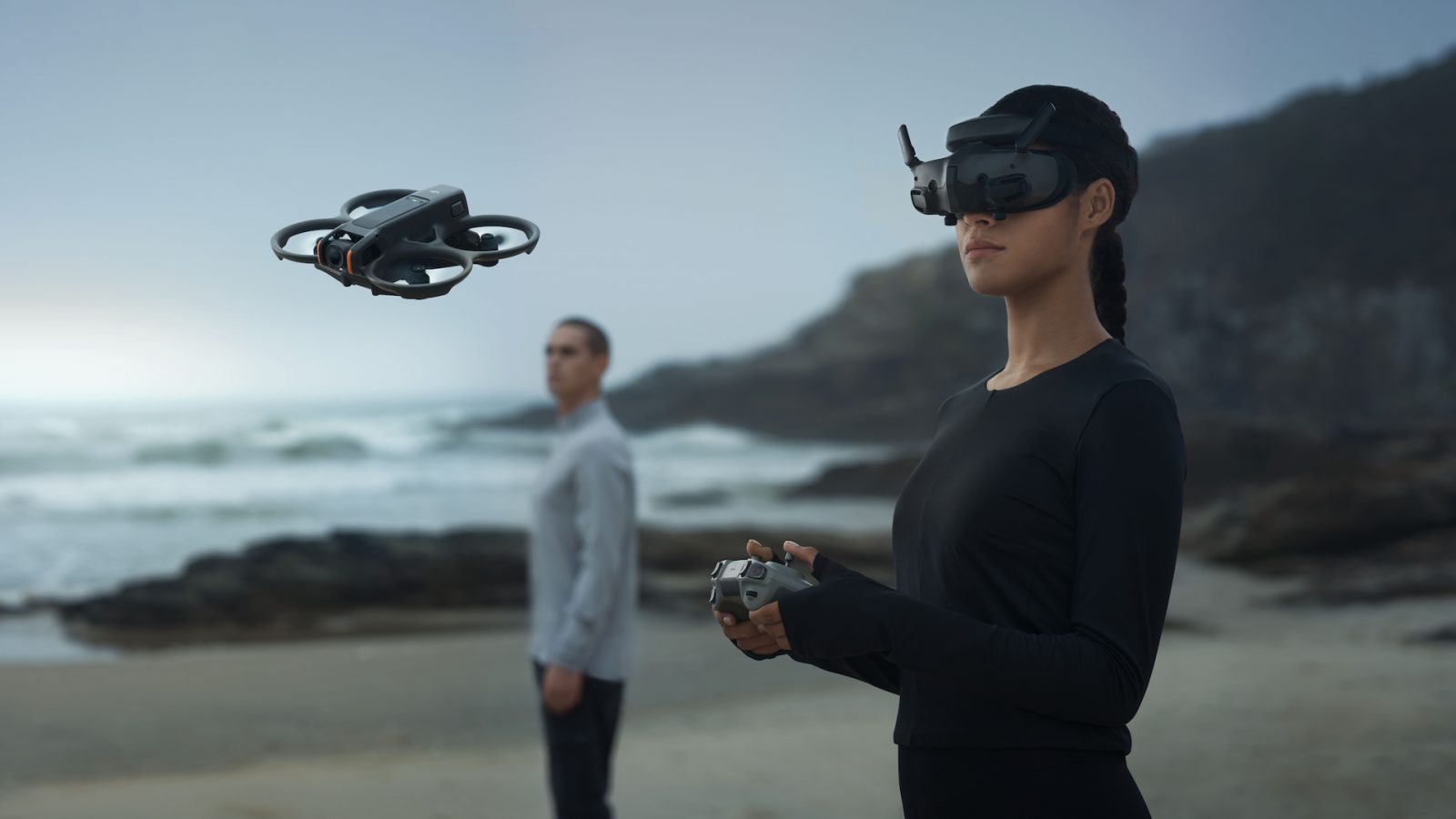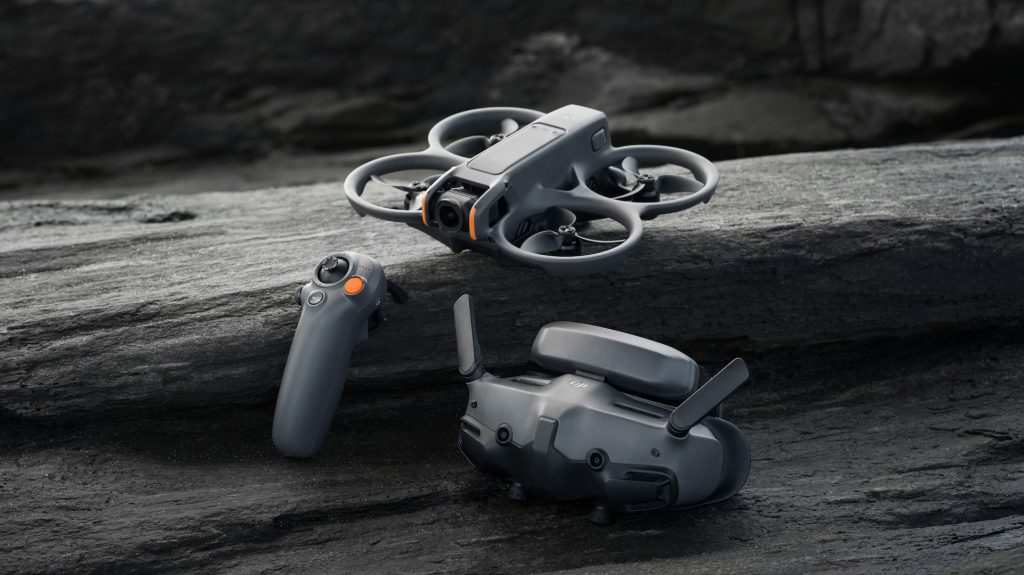
Today, DJI released its second generation FPV/Cinewhoop style drone, the Avata 2. Packing improvements within both the new drone and paired Goggle 3, is it the best FPV drone on the market?
The Avata series just got better
If you have ever flown the first DJI Avata, you’ll understand the ease of taking control and quickly going from beginner to full speed flying. When flying with DJI’s Motion Controller the movements to fly Avata is natural, meaning anyone can do it.
Let’s use myself for instance. I am not an avid FPV flyer. I don’t build any of them, and I’m for sure not out there doing flips and flying in and out of buildings with them. My experience with FPV was a one minute flight demo at a public safety drone demo by UVT last summer. Yes, Avata is being pushed to law enforcement for house clearing usage.
Last week I put on the goggles and powered everything on for the first time and went through the tutorial. By default DJI puts you in Beginner Mode, kind of like cine flight mode from the traditional drones. After about 30 seconds, I was already ready to turn it off and go full speed, which I did and then crashed almost immediately into a playscape. Oops.
Build quality
While crashes with a Mavic, Air, or Mini drones are usually not good, FPV drones are expected to have some crash resilience to them. Clipping branches, walls, and yeah the occasional metal poll, is not unheard of so the Avata 2 has to be built to take it.
Overall the quality is great, the rotor guards protect the rotors from getting any damage if you graze a wall, clip some leaves, or even fly a bit too low into the tall grass.
Avata 2’s turtle mode also allows you to flip the drone over and continue flying after a tumble. And yes, I’ve had to use it a few times. I wish there was a shortcut for this and not hidden behind three menu clicks but it works very well. Maybe a normal pilot doesn’t need it often and it’s just me that keeps crashing it.
When it comes to most obstacles you might come across, Avata 2’s body can take a good beating without any noticeable damage.

However, I wouldn’t suggest flying into anything hard at full speed. As I mentioned before, my first flight ended after clipping a metal poll at a kid’s playground. While the drone is intact with no issues in flying again, the plastic bottle was dented a little bit meaning the rotor blades were touching the guard very slightly.
So while the blades eventually shaved down a bit on the next flight to no longer be touching, you’re probably going to want this repaired as this probably affects the Avata 2’s flight profile in some way. Although, I haven’t notice anything drastic since then.
DJI Goggles 3: The real show stopper
O4 Transmission
While there’s nothing to complain about on the Avata 2, the real improvements in my opinion are with the new DJI Goggles 3. First, the Goggles 3 get a boost to DJI’s new O4 transmission system, increasing the strength and stability of your feed to the drone. O4 originally came out with the Air 3 and is an almost night and day difference between even O3+ that was on the DJI Goggles 2 and original Avata.
The addition of this new system also means a new manual flight controller, the Flight Controller 3. Pretty much the same as previous versions, this will be compatible with the Avata 2 and O4 transmission.
Real world passthrough
The biggest addition, however, is real world passthrough. DJI added two cameras onto the front of the goggles that allow you to look around in your environment. With just a quick double click of the Motion Controller 3’s scroll wheel or a double tap on the side of the Goggles 3, you’re taken out of the flight view and can see the world in front of you.
While it won’t be able to compete with Apple’s Vision Pro, it’s good enough to check your surroundings, find your controller, or even look at your phone! DJI pushes this as a big safety feature and I agree. I used it a few times when I heard voices and caught a group of kids walking up behind me. Although I must admit, I used it to check my phone and respond to texts a lot.

The rest of it
The DJI Goggles 3 are an overall great pair of FPV goggles. The battery has been moved to the back of the head strap, balancing out the front weight a bit. The head strap also now features a dial tightening system, similar to Apple’s Vision Pro strap, which is great and has no slippage so far.
It’s not even too heavy, I haven’t noticed any discomfort while wearing it or any neck fatigue after long flying sessions. While it can take a bit to get set up where you can see all four corners of the internal screens, moving around the diopters to get the screens in focus and in view is easy enough. The real trick I wish DJI would mention is the fit of the goggles on your face. There’s a small adjustable hinge between the goggles and its forehead rest, this helps get the goggles snug up against your face. It’s easy to move it when taking it off or putting it in your bag, so you usually have to readjust it each time.
Once that’s in place, then adjust the diopters using the sticks on the bottom of the goggles. It takes just a minute or two to get it right and it should be rock solid clear, just like you’re looking at any other controller screen.
Compatibility
I have yet to give this a try due to firmware limitations (gotta wait for public firmware for my Mini 4 Pro) but the Goggle 3 and Motion Controller 3 will be out of the box compatible with the Air 3 and Mini 4 Pro. Obviously the upgraded transmission system makes it hard for backwards compatible controllers and goggles, we saw this with both the Air 3 and Mini 4.
This sadly means that we’ll have to wait for an Integra 2 goggles for a cheaper bundle.
Avata 2 boost in overall all specs shows
The Avata 2 came with the expected spec bump that any new generation would get. A larger camera for crisper photos and video, slightly increased flight time, and a few new features like Easy ACRO that gives Motion Controller 3 flyers abilities to do flips, rolls, and drifts.
While the increases mostly came from the Goggles, if you’re an avid FPV pilot, a larger camera will be a welcome one. Easy ACRO is more tailored to the casual pilots like myself and it is fun to play around with. I have yet to try out the normal Flight Controller for manual flight but I guess there’s no better time than the present.
Overall the Avata 2 is another amazing product from DJI. It has everything you expect from the industry leader and even on prerelease firmware, I found no bugs or unexpected crashes of the software.
If you need some new fun in drone flying, or a simple FPV drone to expand your client offerings, the Avata 2 will do you perfectly.
Price
The DJI Avata 2 is available for order today from DJI’s website as well as Amazon (day one already, nice!), starting at $999 for the single battery combo and $1,199 for the three battery combo.
You can also buy just the Avata 2 drone with one battery and nothing else for $489. However, you’ll need to get a controller and goggles that are compatible with the Avata 2, which for right now is just the third generation Motion Controller, Goggles, and Flight Controller.
FTC: We use income earning auto affiliate links. More.




Comments